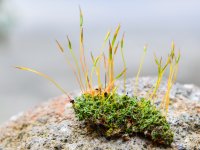Bob Blaylock
Senior Member

A bit of moss, and a botany lesson.
Notice that there are two form of this plant.
The low-leafy plants are gametophytes. These plants are haploid, meaning that each cell nucleus has only one set of chromosomes. In the human life cycle, the only haploid cells are gametes—sperm and egg cells. With moss, the dominant form of the organism is haploid.
Under the right conditions, these gametophytes produce gametes—sperm and egg cells. The egg cells stay in the plant that produced them, while the sperm cells swim off in search of these eggs.
When a sperm cell successfully fertilizes an egg, this produces a sporophyte. That's the tall, stalk-like plants in this picture. Like us, the sporophytes are diploid, meaning that every cell nucleus has two sets of chromosomes, one from each of the gametes that produced it. In the pod at the tip of the sporophyte, meiosis occurs. In us humans, meiosis is the process by which we produce sperm or egg cells. The process starts with one diploid cell, which divides twice, producing four cells. During the process, the chromosomes are duplicated once, and shuffled, so that in the end, you wind up with four haploid cells, each having only one set of chromosomes. In moss, the cells that result from this process are called spores. Eventually, the pod will burst open, dispersing these spores to the wind. Each spore that successfully germinates will produce a new gametophyte.
All plants that have a sexual cycle have this alternation of generations between haploid gametophytes and diploid sporophytes. In moss, the gametophyte is the dominant form of the plant. With ferns, it is the sporophyte that is the dominant form, with the gametophyte having been reduced to a small inconspicuous plant that you'd rarely ever notice. In seed-bearing plants, the gametophyte has been reduced to just a few cells; with the male gametophyte being contained in a grain of pollen, and the female gametophyte never leaving the flower or cone in which it is formed.
